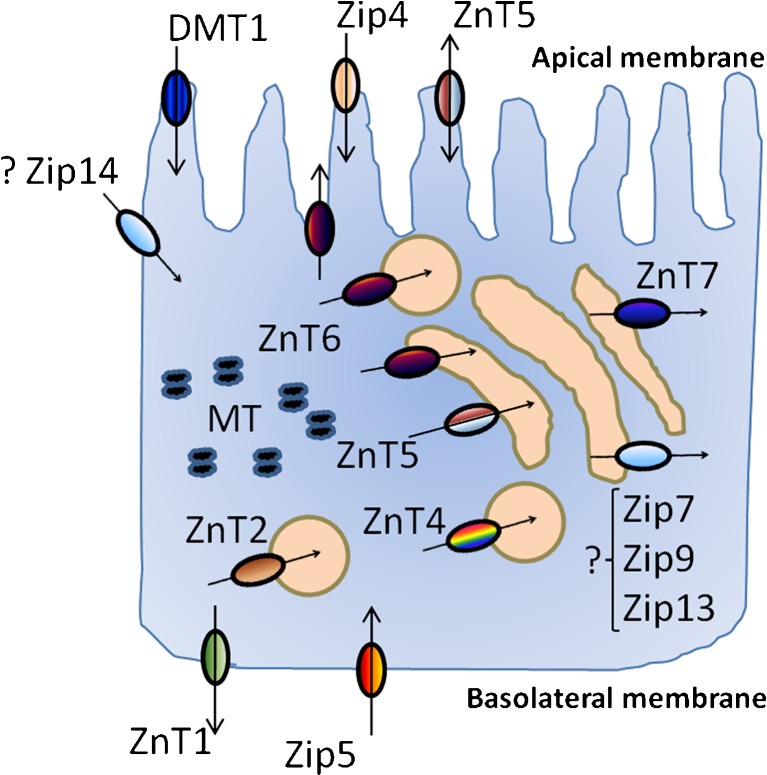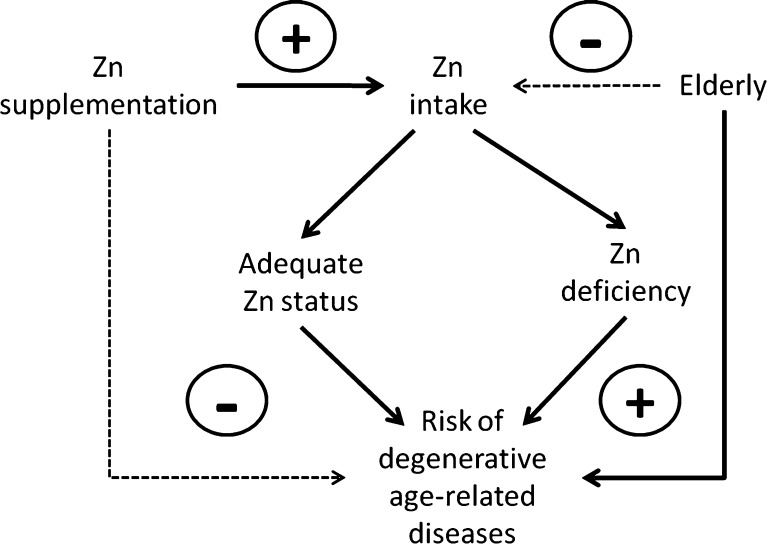Mocchegiani Eugenio, et al.
Age, 2013
Abstract
The diet in the elderly does not provide a sufficient level of nutrients needed to maintain an adequate healthy status leading to micronutrient deficiencies and impaired immune response with subsequent development of degenerative diseases. Nutrient "zinc" is a relevant micronutrient involved in maintaining a good integrity of many body homeostatic mechanisms, including immune efficiency, owing to its requirement for the biological activity of many enzymes, proteins and for cellular proliferation and genomic stability. Old people aged 60-65 years and older have zinc intakes below 50% of the recommended daily allowance on a given day. Many causes can be involved: among them, altered intestinal absorption, inadequate mastication, psychosocial factors, drugs interactions, altered subcellular processes (zinc transporters (Zip and ZnT family), metallothioneins, divalent metal transporter-1). Zinc supplementation may remodel the immune alterations in elderly leading to healthy ageing. Several zinc trials have been carried out with contradictory data, perhaps due to incorrect choice of an effective zinc supplementation in old subjects showing subsequent zinc toxic effects on immunity. Old subjects with specific IL-6 polymorphism (GG allele carriers; named C-) are more prone for zinc supplementation than the entire old population, in whom correct dietary habits with foods containing zinc (Mediterranean diet) may be sufficient in restoring zinc deficiency and impaired immune response. We summarise the main causes of low zinc dietary intake in elderly reporting an update on the impact of zinc supplementation upon the immune response also on the basis of individual IL-6 polymorphism.
Figures
 Zinc transporter pathways, zinc carrier (DMT1) and MT in a polarised enterocyte. Zip4 and Zip5 are involved in zinc influx and efflux, respectively. ZnT5 in both influx and efflux. ZnT1 in zinc efflux. ZnT6 is involved in various tasks: zinc efflux and zinc storage in specific vesicles named “zincosomes” and in Golgi apparatus. ZnT2 and ZnT4 in zinc storage in zincosomes. ZnT7 in zinc storage in Golgi apparatus. DMT1 is involved in zinc uptake. MT are involved in intracellular zinc homeostasis for zinc signalling. Zip4, ZnT5, and DMT1 are present in apical membrane, whereas ZnT1 and Zip5 in basolateral membrane. The specific localization of Zip14, involved in zinc and iron uptake in enterocyte, is still unclear and remains to be established as well as the specific function of Zip7, Zip9 and Zip13 expressed in the Golgi apparatus of enterocyte (question marks)
Zinc transporter pathways, zinc carrier (DMT1) and MT in a polarised enterocyte. Zip4 and Zip5 are involved in zinc influx and efflux, respectively. ZnT5 in both influx and efflux. ZnT1 in zinc efflux. ZnT6 is involved in various tasks: zinc efflux and zinc storage in specific vesicles named “zincosomes” and in Golgi apparatus. ZnT2 and ZnT4 in zinc storage in zincosomes. ZnT7 in zinc storage in Golgi apparatus. DMT1 is involved in zinc uptake. MT are involved in intracellular zinc homeostasis for zinc signalling. Zip4, ZnT5, and DMT1 are present in apical membrane, whereas ZnT1 and Zip5 in basolateral membrane. The specific localization of Zip14, involved in zinc and iron uptake in enterocyte, is still unclear and remains to be established as well as the specific function of Zip7, Zip9 and Zip13 expressed in the Golgi apparatus of enterocyte (question marks)
 Potential effect of Zn supplementation in preventing risk (minus sign) of degenerative age-related diseases in the elderly in comparison to zinc deficiency and risk of degenerative diseases (plus sign)
Potential effect of Zn supplementation in preventing risk (minus sign) of degenerative age-related diseases in the elderly in comparison to zinc deficiency and risk of degenerative diseases (plus sign)| PMID: | 22222917 |
|---|---|
| PMCID (Free PMC Article): | PMC3636409 |
| DOI: | 10.1007/s11357-011-9377-3 |
| Category: | Immune |
The best supplements with Zinc in Immune category:
- Zinc Picolinate, 100 Tablets (Solgar) - Zinc promotes healthy skin and supports normal taste and vision. It contains among others: Zinc.
- Immune Defence - Zinc Lozenges with Rosehip and Acerola - Your immune system needs daily support to stay in good form, to be able to fight off any pathogens trying to enter your system and to witstand the impact of stress on your body and mind. It contains among others: Zinc.
- L-OptiZinc, 30 mg, 100 Veg Capsules (Now Foods) - L-OptiZinc is a form of Zinc complexed with the amino acids Methionine. It contains among others: Zinc.
- Zinc, 50 mg, 250 Tablets (Now Foods) - Zinc is essential to the normal function of many organs and systems within the body including the skeletal, immune, neurological, and endocrine systems. It contains among others: Zinc.
- Zinc Picolinate, 50 mg, 120 Veg Capsules (Now Foods) - Zinc is essential to the normal function of many organs and systems within the body including the skeletal, immune, neurological, and endocrine systems. It contains among others: Zinc.
Articles similar to "Zinc: Dietary Intake and Impact of Supplementation on Immune Function in Elderly."
- The significance of Zinc for Immune: Zinc as a Gatekeeper of Immune Function. (After the discovery of zinc deficiency in the 1960s, it soon became clear that zinc is essential for the function of the immune system...)
- The role of Zinc in Immune: Zinc Signals and Immunity. (Zinc homeostasis is crucial for an adequate function of the immune system...)
- The impact of Zinc on Immune: Roles of Zinc Signaling in the Immune System. (Zinc (Zn) is an essential micronutrient for basic cell activities such as cell growth, differentiation, and survival...)
- The significance of Zinc for Immune: Zinc and Immunity: An Essential Interrelation. (The significance of the essential trace element zinc for immune function has been known for several decades...)
- The role of Zinc in Immune: Zinc, Aging, and Immunosenescence: An Overview. (Zinc plays an essential role in many biochemical pathways and participates in several cell functions, including the immune response...)
- The impact of Zinc on Immune: Zinc Signals and Immune Function. (For more than 50 years, it has been known that zinc deficiency compromises immune function...)
- The role of Zinc in Immune: Zinc in Innate and Adaptive Tumor Immunity. (Zinc is important...)
- The impact of Zinc on Immune: Zinc in Human Health: Effect of Zinc on Immune Cells. (Although the essentiality of zinc for plants and animals has been known for many decades, the essentiality of zinc for humans was recognized only 40 years ago in the Middle East...)
- The significance of Zinc for Immune: Immune-enhancing Role of Vitamin C and Zinc and Effect on Clinical Conditions. (Vitamin C concentrations in the plasma and leukocytes rapidly decline during infections and stress...)
- The role of Zinc in Immune: Zinc: Role in Immunity, Oxidative Stress and Chronic Inflammation. (Purpose of review: Zinc is essential for multiple cellular functions including immunity...)
Previous article
Zinc Homeostasis and Signaling in Health and Diseases: Zinc Signaling.

























































